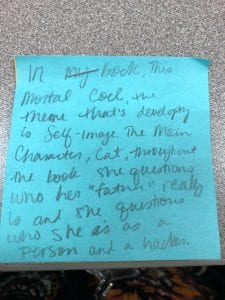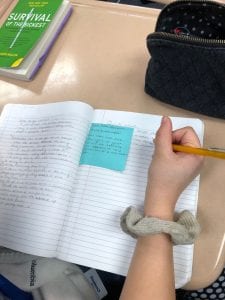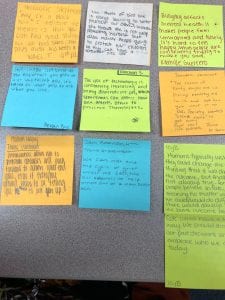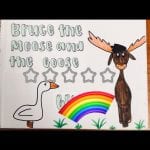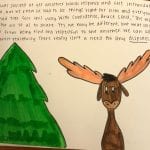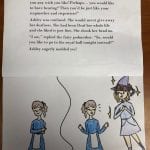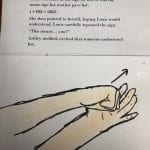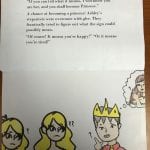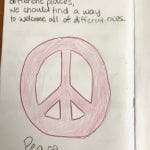Organic Casual Simple Email Newsletter by Jenna Zucha
A Fresh Approach to the Personal Narrative
Having students start their writing journey through the lens of personal experience encourages them to stop and reflect on the moments, people, and places in their lives. Reflection can be difficult at any age, but students are rarely given an opportunity to dig deeper into what they have learned from their experiences, and more importantly, what others might also learn from those shared stories. Activities like this help build a writing community that will continue to grow as the school year progresses.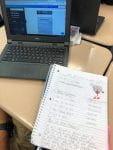
This year, I asked students to reflect on their life experiences by designing a book jacket that encompasses not only the memories that have impacted them the most but also encapsulates their personality, style as a writer, and images they feel represents them best.
The Process
Start with the writing:
Students start by creating a chart to collect the people, places, and moments that stood out in their minds as important or impactful. We spent several days flash drafting and conversing in small groups about our lives, friends, family, beloved pets, and fondest memories. I wanted students to know that writers write from their own lives; they write from places of both joy and pain.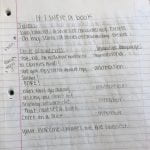
Mentor texts as Inspiration:
Students were encouraged to pick books for their independent reading that would reinforce the narrative style they are practicing in class. Memoirs, autobiographies or fiction told from the 1st person POV set the tone for our daily quick writes, discussions, and mini-lessons. I also shared my writing territories with them and modeled how helpful feedback can be during the writing and revising process.
Tech tools for creating and publishing:
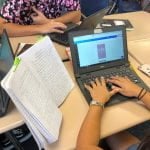 We used Canva.com to create our books. This on-line tool offers many free templates, designs, fonts, and images students can utilize to design a final product they are proud to share with their peers.
We used Canva.com to create our books. This on-line tool offers many free templates, designs, fonts, and images students can utilize to design a final product they are proud to share with their peers.
Publishing and sharing:
Projects are due on Tuesday, September 10. Students will come to class with a print out of their title page with a QR code that links us to the full version of the project. Writers will walk around reading each other’s work, leaving positive feedback for their peers, and celebrating their hard work. More pictures of that process to come!!!!
Sincerely,
Ms. Zucha
Building Student Interest in Research through Multi-Genre Inquires and Online Learning Pathways
I am excited to share the two major changes I am implementing in my English II Leadership classes this year:
- A switch from traditional research papers to a Multi-Genre Research Project
- Transferring the pre-writing and preliminary searches for the research proposal to Learning Pathways on Its Learning.

My Teaching Goals:
- This year I wanted students to think about the role research plays in society and how the consideration of multiple perspectives can shape our interpretation.
- I wanted to utilize the online tools available to my students to potentially streamline the process.
Why a genre study? One of the main focuses of the Readers/Writer’s workshop is on the writer’s craft and how that craft is shaped by the writer’s intended audience and message. In a multi-genre style research project students must consider the message or theme they are attempting to present to a larger audience and how the choices they make in the genre will heighten some aspects of their research but may limit others. I think that when students not only make choices in content but in the writing craft and design of their product, they are becoming more contentious as writers overall.
Want to know more about Multi-genre research projects? Check out these helpful resources:
What does a Learning Pathway look like in an English class? I started by giving students detailed instructions over the whole project including goals, expectations, due dates, and things to consider. The next step in the learning pathway was a quiz, in which I asked students questions about the most important elements from the instruction sheet. Passing this quiz takes them to the next step, a personal interest survey. Students are prompted to think about the people or issues in their lives that mean a great deal to them. I also linked them to websites within the survey that might spark ideas. 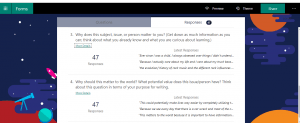 Once they have completed the interest survey, they move on to an Office 365 forms that prompt them to free write on a potential topic. I asked two questions in the form:
Once they have completed the interest survey, they move on to an Office 365 forms that prompt them to free write on a potential topic. I asked two questions in the form:
- Why does this subject, issue, or person matter to you? (Get down as much information as you can; think about what you already know and what you are curious about learning.)
- Why should this matter to the world? What potential value does this issue/person have? Think about this question in terms of your purpose for writing.
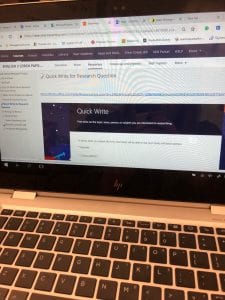
After completing the quick write, students move on to the next step in the Learning Pathway, a writing conference with the instructor. I added a one question test to the learning pathway, and once students met with me to discuss their ideas for topics, I entered the password to the one question test. This unlocks the rest of the learning pathway for students and ensures that I have met face-to-face with each student before they begin their research.
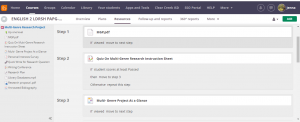 From this point, students watch a quick tutorial video on using library databases that I created using ScreenCastomatic; a free computer screen recording app. Students begin working on collecting sources for their annotated bibliographies which is the last step in the Learning Pathway.
From this point, students watch a quick tutorial video on using library databases that I created using ScreenCastomatic; a free computer screen recording app. Students begin working on collecting sources for their annotated bibliographies which is the last step in the Learning Pathway.
Overall First Impressions: Students seemed to really like the pathway set-up and were fully engaged in the process. The writing conference over the Quick Write worked well and I was able to keep track of where students were in the process by using Office 365 Forms because it would repopulate every time a student added to it. I will defiantly be using Learning Pathways again, and I am already thinking of the different ways to incorporate into all my classes.
If you are interested in using this tool in your own classroom, leave me a comment or email me to set up a tutorial session. I would love to help you brainstorm ways to use this in your own classroom!
Guiding Students to Think More Deeply About Themes in Independent Reading:
Finding time to talk with students about their books in any meaningful way can be difficult. Teachers are limited by time, managing many students at once, and discovering the magical combination of words to say to a student that will get them talking about their book beyond the plot. I wanted to share a strategy I have been using this year that has really helped me tackle all three of these concerns in my own classroom.
The Power of the Almighty Sticky-Note!
You guys, I love sticky-notes. I love the colors, the different sizes, and the versatility. We use sticky-notes in class for almost everything; annotating mentor texts, peer editing, exit tickets, and conferring correspondents. Sticky-notes allow students to share what they are thinking, questions they have, and the little things they notice in a whole-group discussion.
Listen, here is the thing about conferring:
I enjoy the time I have to talk to kids about books and I wish I had the entire class period to do this. I usually will sneak in opportunities to talk to students during passing periods, during independent work, or during our reading time every day. However, these brief interactions rarely extend beyond the base-level questioning. That’s where the charm of sticky-notes comes in. I can ask students an open-ended question, like “What is a theme developing in your book?” and students write their responses on the colorful notes. Now I have a snap-shot into their cognitive process. I can quickly assess how closely they are reading, and I can assess their ability to construct higher-level reasoning through their thoughts on theme.
Getting My Students to Dig Deeper:
In this example, you will see how one of my students is picking up on the importance of a single issue and has started to question the character development and its significance to the author’s message, but she has not quite gone far enough.
So, I did a little research on her book to see how I could help her dive below the surface and think beyond the plot structure. I asked her to explore the importance of family and identity, which ties in with her 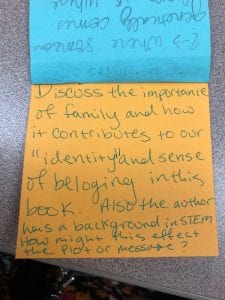 comment about the father, and then I gave her something more to research. The author has a background in STEM and I want the student to think about the author’s intentions and influence. This intrigued her, and she spent some time learning more about her author. It helped explain the role genetics was playing in the book too.
comment about the father, and then I gave her something more to research. The author has a background in STEM and I want the student to think about the author’s intentions and influence. This intrigued her, and she spent some time learning more about her author. It helped explain the role genetics was playing in the book too.
Each response is personalized (this does not take as long as you would think) and the questions and comments I give them pushes them to write more in their notebooks.
Building Leadership and Literacy by Shattering the Single Story
For the past few years, I have been using Chimamanda Ngozi Adichie’s Ted Talk, The Danger of a Single Story in my Pre-AP Leadership classes. In her message, she cautions writers and readers to be wary of the single story, which “emphasize[s] how we are different rather than how we are similar.” Adichie is the author of several amazing books, like Americanah and We Should All Be Feminists. I have her latest book, Dear Ijeawele, or A Feminist Manifesto in Fifteen Suggestions, on my “What to Read Next” list.
You can watch her describe her new book here.
In her Ted Talk, Adichie explains that “the problem with stereotypes is not that they are untrue, but that they are incomplete.” This aspect of her message has always resonated with my students. When I do the end-of-the-year surveys this lesson is brought up over and over again. I share this with them at the beginning of the school year, so for them to remember the message is a big deal, and it speaks volumes towards the power of Adichie’s influence.
Changing it up:
In the past, I would usually have the students watch the Ted Talk video, annotate the transcript, participate in a Socratic seminar, write a response, and move on. This year, we started by having a class discussion over the video and students generated a list of claims made by the author and points to extend. They discussed stories that have shaped their perspectives as children, marginalized groups who are underrepresented in film and other forms of art. This led them to the idea of potentially creating their own children’s book that would break a stereotype or tell a more socially responsible tale for a marginalized group. I had never done this before but I was excited to support them in taking ownership of their learning!
My students blew me away with the work they did! Some students updated classic fairytales, some used online tools like storybird and storyboardthat.com to create digital books, and some created entirely new storylines and plots to support a wide range of groups and topics.
We used mentor texts like
Students anal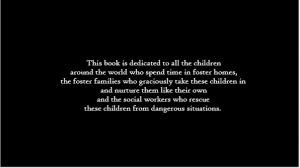 yzed the common elements shared by the mentor texts and discussed style, language, and formatting. We also considered how each author handled the delicacy of the topic and how you can create a forward or afterward to explain your thinking.
yzed the common elements shared by the mentor texts and discussed style, language, and formatting. We also considered how each author handled the delicacy of the topic and how you can create a forward or afterward to explain your thinking.
Here is a small sampling of the amazing products they came up with:
Students Reflecting on the Learning Process:
As a follow up to this assignment I had my students complete a reflection that asked them to analyze the project in 4 core areas;
- What lesson or takeaway do you have from this project?
- What challenges did you face working with a group and how did you attempt to overcome those challenges?
- What is your major contribution to the group and why were your skills or input invaluable?
- How would you extend this lesson or connect it with something else you have learned in another subject (History, Physics, Art, Math)?
I think this was my favorite part of this process. All of the responses were thoughtful and made connections to their lives outside of my classroom. Overall I am pleased with the results.
Reading & Writing Summer Challenge
I love this time of year! It is invigorating to watch student’s countdown the last few school days until summer while listening to all their plans for the much-needed break. With all this talk of road trips and poolside fun, it is easy to overlook the need to prepare for the upcoming school year.
That is why I encourage my young scholars to keep the momentum going with their writing and reading habits. I challenge you to incorporate these creative tips into your summer plans to strengthen the mind.
Tip #1 Just keep reading…
I like to start my summer planning by making a list of books I want to read over the break. I think it is important to maintain a wide variety of titles on your list. 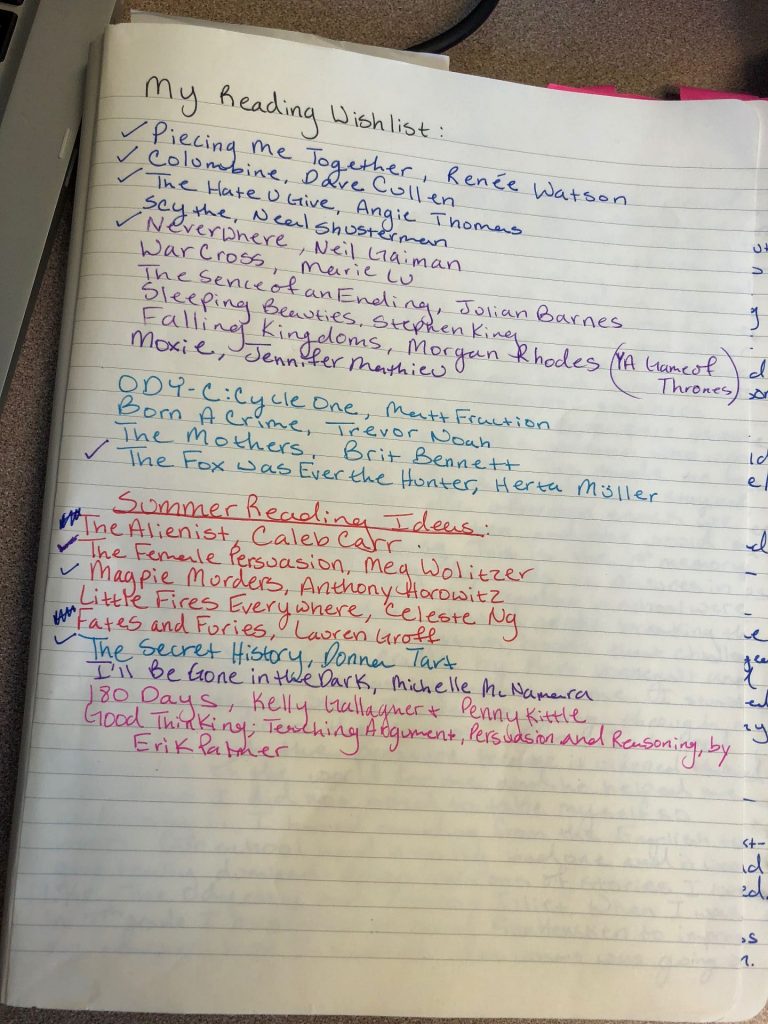 Some books on my list are for professional development and academic growth, but I also include books for pleasure and lighter reading. The important thing is to find time for reading every day. Here are a few lists to help you get started.
Some books on my list are for professional development and academic growth, but I also include books for pleasure and lighter reading. The important thing is to find time for reading every day. Here are a few lists to help you get started.
- Books for the college bound
- Award Winners
- Ultimate AP Literature Book List
- NPR Book Concierge
- Zucha’s summer recommendations
Tip #2 Hold yourself accountable…
It is easy to set goals but it is much harder to follow through on these goals. You can establish accountability simply by talking to others about the books you are reading.
I like to encourage parents to read with their children and discuss the themes they discover along the way. Reading a book with another person is a very enjoyable and rewarding experience.
Set up mini book clubs with your closest friends. You can pick a day to meet at someone’s house or coffee shop to discuss the book. For most books, you can easily find discussion questions online, or as preparation for the upcoming school year, create your own questions using Socratic Seminar sentence stems. 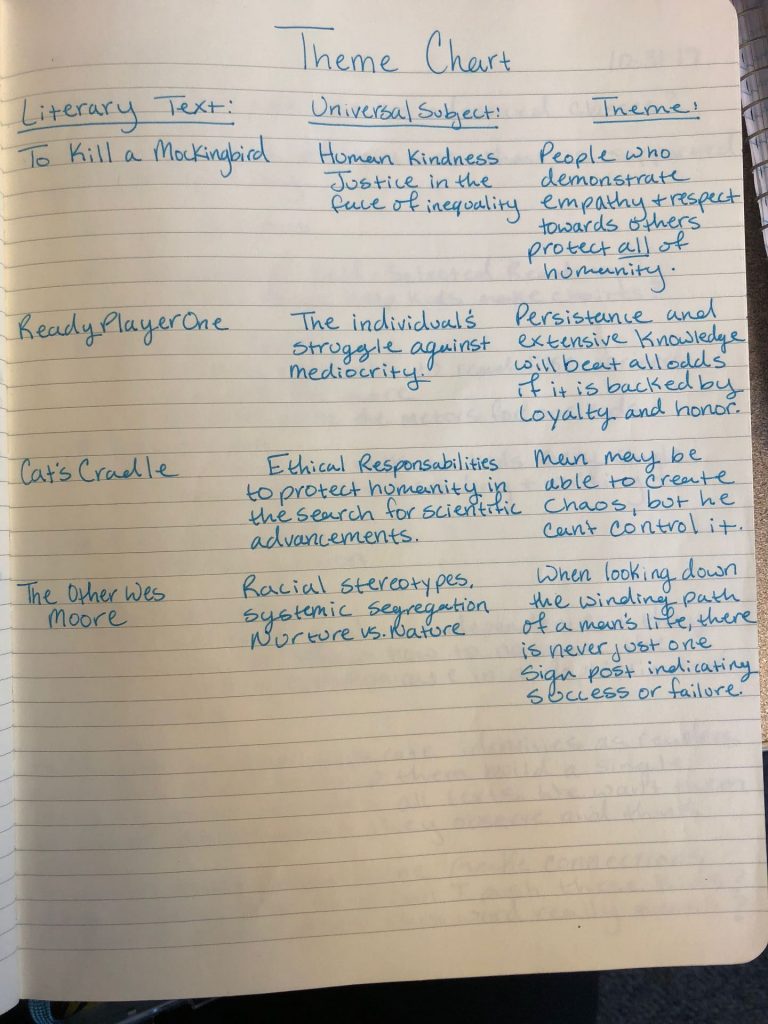 I like to keep theme-charts in my writer’s notebook and I will collect quotes from the books I am reading to return to later or use as support in my writing.
I like to keep theme-charts in my writer’s notebook and I will collect quotes from the books I am reading to return to later or use as support in my writing.
Tip #3 Commit to a writing challenge…
The website, Movingwriters.org is challenging students and teachers to 100 days of writing! Rebekah O’Dell expounds on the importance of exercising your writing skills just like any other muscle in your body. Good writing can be difficult to achieve because it requires two things: a command of language and informed autonomous thought. The AP Language and Literature courses require students to read a variety of texts with a critical eye that establishes the author’s purpose but also considers a range of perspectives within the cultural and historical context. Commit to writing and reading every day to strengthen your critical thinking skills.
Tip #4 Feed your curiosity…
Take time this summer to learn new things and challenge your perspectives. Below you will find a few suggestions on how to start practicing looking at the world through a critical eye and joining the global conversation.
- Listen to podcasts like Radiolab or How Stuff Works to gain exposure to exciting ideas and new research.
- Follow online news sources that combine current events with academic rigor like The Conversation and The New York Times Learning Network.
- Follow your favorite authors on Twitter and ask them questions about their books.
- Visit local heritage, art, and the natural history museums.
Summer Reading Recommendations: Part One
Favorite things about the summertime:
- Pools
- Sleeping in
- Reading all day!!!
Here are a few books I am excited about.
The Beauty That Remains, Ashly Woodfolk
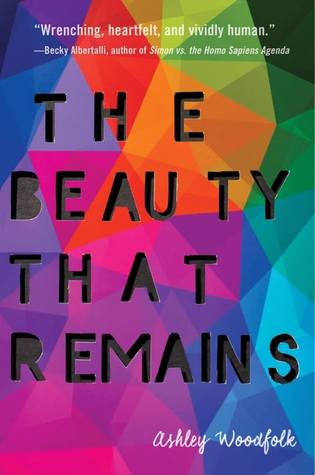
I have a strong inclination towards music and many moments in my life have been chronicled by the albums or songs that were occupying my mind at the time. The Beauty That Remains is told from three unique points of view (Autumn, Shay, and Logan have all lost someone) and the story unfolds through lyrical prose that will captivate your heart and musical soul.
Down and Across, Arvin Ahmodi

Feeling lost and overwhelmed by the many twists and turns life throws at you is perhaps a feeling we are all familiar with, but it is especially overwhelming in high school when college is looming on the horizon and you have yet to find a passion to drive your forward. Scott Ferdowski, a high school senior in Washington D.C, lacks “grit” and direction but is given an opportunity to discover himself, his city, and a mysterious girl in this contemporary coming-of-age novel.
Americanized: Rebel Without a Green Card, Sara Saedi

As a 90s kid, I get nostalgic for references to the decade and Sara Saedi combines 80s and 90s teen pop-culture with the turbulent life of a young undocumented immigrant from the Middle East. Saedi effortlessly transitions between her fears of deportation and her relatable moments of teenage angst. Altogether, she creates a strong sense of empathy for this uncharted world of living in America in the 90s, being 13, and unwittingly breaking the law.
Poet X, Elizabeth Acevedo
The poet and author, Dylan Thomas said that “Poetry is what in a poem makes you laugh, cry, prickle, be silent, makes your toe nails twinkle, makes you want to do this or that or nothing, makes you know that you are alone in the unknown world, that your bliss and suffering is forever shared and forever all your own.” The amazing slam poet, Elizabeth Acevedo encapsulates all the feels, plus some in her poetic account of Xiamara Batista’s life in verse. Check out an exclusive excerpt read by the author and see for yourself!
I will have more books to share next week. Happy Reading!
Chronicles in Conferring
I was so excited when Charles Moore asked me to write a guest post for The Three Teachers Talk community. After meeting Amy Rasmussen and reading posts like Writing Heals. Writing Assignments Do Not and How to Confer Like a Ninja, I’ve learned solid strategies for engaging my students in authentic writing that matters to them. I identify as a reader and a writer and both are a big part of my personal and professional life. So, it is no surprise that my favorite part of this job is conversing with students about their writing and reading lives! 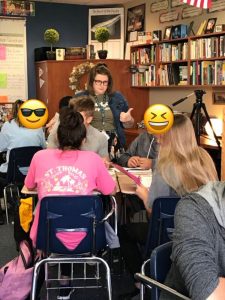
At the start of the school year, my conversations were very informal and sporadic; I tended to focus more on traditional feedback like formatting, conventions, and organization. But, with no end-goal or clear means to measure if these conferences were actually improving my student’s abilities to think like writers, I quickly lost trajectory. Luckily, I found real direction after reading, Minds Made for Stories, by Thomas Newkirk and Writing with Mentors, by Rebekah O’Dell and Allison Marchetti. Both books inspired me to weave together writing advice and mentor texts each student could use in the moment. Charles Moore showcases some great resources for similar strategies in his post, Formative Assessment Works!!!
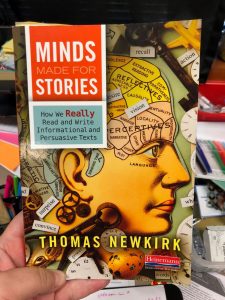 A Look Inside My Classroom; Conferencing & Sharing Mentor Texts
A Look Inside My Classroom; Conferencing & Sharing Mentor Texts
Setting the Scene: Sarah, a music enthusiast, has been working on a song analysis essay for a few weeks and she was getting frustrated with her lack of progress. I met with her on several occasions, narrowing her choices in artists and songs, until she had a solid plan for her draft. Suddenly, she felt like “it just wasn’t going anywhere,” and she was ready to abandon the project entirely. I think we’ve all seen this before; it was a classic case of “I know what I want to say, but I don’t know how to say it.” She was also suffering from the mind-numbing effects of having more material than she could manage. What to do?
The Intervention: In response to Sarah’s crises and hearing similar angst from other students, I decided to have them all conduct a peer-to-peer conferencing activity. Students would read each other’s drafts and provided feedback that both praises the connections made and presses the writer to stretch a little more.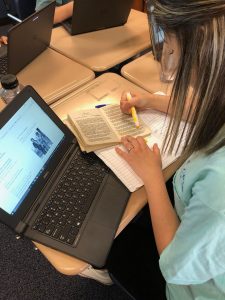
The Sharing Magic: Sarah decided to exchange her draft with another student who is really into writing poetry and has published several poems during Workshop this year. The two writers discuss, and Sarah is immediately rejuvenated by her partner’s comments and recommendations. Her partner suggests that she use lines from the songs she has analyzed to write her own epic poem.
My Teachable Moment: As she is emphatically exclaiming her eureka moment, I turn to the bookshelf behind me and grab an annotated translation of Dante’s Inferno. I hand her the book and begin to explain how Dante created elaborate allusions in his poem that are illuminated by the translator’s detailed footnotes. Sarah now had a mentor text to help guide her through the treacherous depths of poetry composition and analysis. The next day I brought her a copy of Your Own, Sylvia by Stephanie Hemphill. A portrait of the poet’s life told in a collection of verse. Each poem includes insightful footnotes that Sarah could use as a model for her own writing.
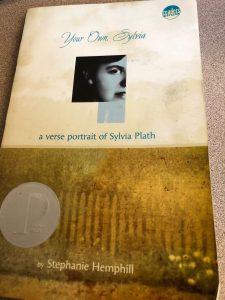
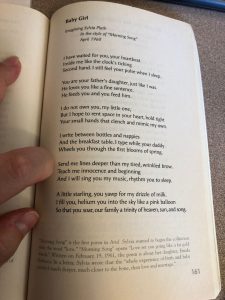
The Final Act: I was so happy to see a copy of Dante’s Inferno and Your Own, Sylvia on the desk of a student who had spent the entire first semester fighting me to read anything other than mystery novels. Not only was she growing as a writer, she was also growing as a reader. Funny how it works like that.
Jenna Zucha is an English II Pre-AP teacher at Clear Springs High school. She is currently reading Trevor Noah’s Born a Crime and looking forward to devouring her summer reading list!
Blogs as Mentor Texts
I wanted to take a moment to share some “go-to” resources I’ve used in the past when I am in need of inspiration for new/compelling mentor texts. Below you will find an incomplete list of blogs that might propel student writing beyond the classroom and generate some more enthusiasm for reading.
Now, I’ve developed a multi-layer lesson I am working on with my students this semester to transform their conversations about books into published pieces, but feel free to use the list as a source for potential mentor texts in your own classroom. My next post will be on podcasts: Where to go, How I use them and ideas I have for the classroom.
Objective: Students are exposed to a community of readers and writers that publish regularly and flourish by sharing ideas with the world. Empowering students to publish their writing right now while analyzing the way author’s discuss novels and the writer’s craft. Students will publish their own post on a book(s) they would like to share with the world.
Links to blogs:
- This is a great place to find reviews for the books that are popular right now with our students. The link below will take you to her review of Erika Sanchez’ book, I’m Not Your Perfect Mexican Daughter. You can talk to students about organization and style techniques used by the blogger to keep readers engaged.
- Brain pickings is one of my favorites! So many thought provoking articles and posts that could jump start any lesson on reading or writing. The link below will take you to a post written by the author, Neil Gaimen, on why reading is crucial to propelling human development.
https://www.brainpickings.org/2016/08/03/neil-gaiman-view-from-the-cheap-seats-reading/
- The Nerdy Book Club is a community of readers who write about books for children and young adults. The link below will take you to a review of Matt Del La Pena’s picture book, Love.
- Looking for poetry? Check out The New Yorker’s “Page Turner” blog post on the poems that shaped 2017
https://www.newyorker.com/culture/2017-in-review/our-year-in-poems
If you have any mentor text resources you use as inspiration or have ideas for using blogs in your classroom, please leave me a comment below.
Happy Reading!
Teaching Cormac McCarthy’s The Road
In Defense of The Road:


McCarthy has undoubtedly established himself as part of the American canon through his unique prose style and distinctive narrative structures in novels like Blood Meridian (1985) and All the Pretty Horses (1992). In 2006 he was recognized by the Pulitzer Prize committee and won the award for distinguished fiction by an American author in 2007 for The Road. At the heart of this novel, you will find a love story between a father and his son. McCarthy had his first son much later in life and he dedicates this novel to him. As a much older man fixed with the task of raising a child, he was confronted by his mortality and the looming certainty that he would not be there to see his son mature, nor would he be there to guide him through the many roadblocks we all face growing up. On the Pulitzer’s website Allen A. Knopf accurately summarizes the impact this novel has on the world of literature, and why I have chosen to teach it;
“The Road is the profoundly moving story of a journey. It boldly imagines a future in which no hope remains, but in which the father and his son, ‘each the other’s world entire,’ are sustained by love. Awesome in the totality of its vision, it is an unflinching meditation on the worst and the best that we are capable of: ultimate destructiveness, desperate tenacity, and the tenderness that keeps two people alive in the face of total devastation” (Knopf, 2006).
More specifically, this novel introduces students to several literary techniques they will need to know presently and in the near future. McCarthy writes in a seemingly simplified manner, but much like poetry, each word is packed full of symbolism, allusion, and metaphor. From the opening passage we see McCarthy alluding to Plato’s Allegory of the Cave, and following the trope of “a hero’s journey,” he places his protagonist in a “dark wood,” which is an indirect reference to Dante Alighieri’s Inferno from The Divine Comedy. We will be reading Dante’s Inferno after The Road and it serves as a perfect precursor to the moral and social criticisms explored in Dante’s contrapasso. Both Alighieri and McCarthy utilize Homeric style similes to bridge the gap between the known reality and the unknown world of their fictional narratives. Students will need to be able to recognize, decipher, and create Homeric similes for the Mastery project at the end of the semester. McCarthy’s simplistic syntax and irreverence for traditional grammar rules contextualizes
The Road as an allegory depicting “a postmodern understanding of the function of language” in a collapsing society (Blasi, Gabriella 90).
Basically, McCarthy is exploring the role language plays in establishing, reinforcing, and contradicting societal laws that are in direct opposition to natural law. This introduction to the complex laws of language will be important when students begin reading Modernist authors like Woolf, Yeats, and Elliot during the 2nd semester and their senior year. In addition to this, the second semester of this year will begin with John Steinbeck’s, The Grapes of Wrath, and students will see a similar division between respecting human rights against prescribed social and governmental constraints as The Joad family journeys to the West coast in search of relief from the Dust Bowl.
One of the essential concepts we discuss in world literature is the importance of perspective. Students were first introduced to this concept through Scout’s viewpoint in To Kill a Mockingbird. Lee understood that the child’s voice is uncorrupted by established social constructs, taboos, and erroneous stereotypes which often convolute the minds of adults. This is literally reinforced in The Road when McCarthy strips these constraints away from his post-apocalyptic world to illuminate the power of love and the desire to remain “the good guys” above all else.
This novel has so much to offer beyond the setting and plot. I personally enjoy all this novel has to offer its readers, and I would encourage all the parents to read it if they have a chance.
Works Cited:
Blasi, Gabriella. “Reading Allegory and Nature in Cormac McCarthy’s The Road. Towards a Non-Anthropocentric Vision of the Language of Nature.” Reading Allegory and Nature in Cormac McCarthy’s The Road. Towards a Non-Anthropocentric Vision of the Language of Nature. N.p., 27 June 2014. Web. 14 Oct. 2015.
Knopf, Alfred A. “The Pulitzer Prizes | Works.” The Pulitzer Prizes | Works. N.p., n.d. Web. 14 Oct. 2015.
Image: Burmester, Jason. “Walking Down a Lonely Road.” March 29, 2008.
Additional Resources:
Cant, John, ed. The Cormac McCarthy Journal (2008): n. 2009. Web. 14 Oct. 2015.

